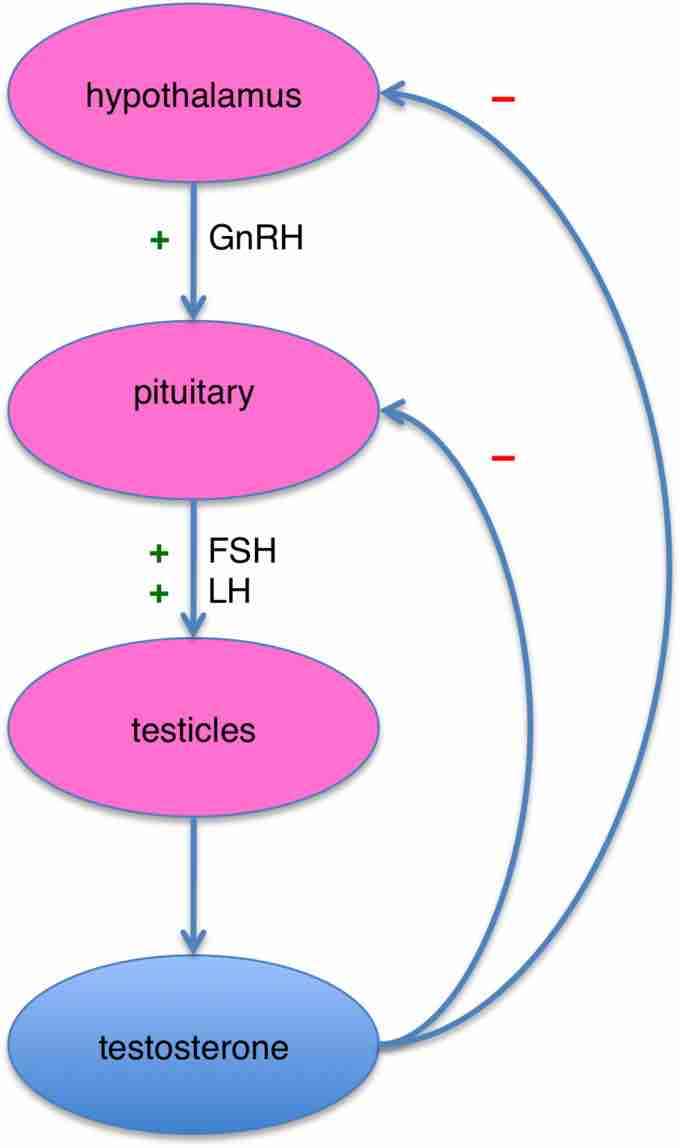Hormonal Regulation of the Reproductive System
Regulation of the reproductive system is a process that requires the action of hormones from the pituitary gland, the adrenal cortex, and the gonads. During puberty, in both males and females, the hypothalamus produces gonadotropin-releasing hormone (GnRH), which stimulates the production and release of follicle stimulating hormone (FSH) and luteinizing hormone (LH) from the anterior pituitary gland. These hormones regulate the gonads (testes in males and ovaries in females); they are called gonadotropins. In both males and females, FSH stimulates gamete production and LH stimulates production of hormones by the gonads. An increase in gonad hormone levels inhibits GnRH production through a negative feedback loop .

The negative feedback loop of the male reproductive system
GnRH, secreted by the hypothalamus, stimulates the production of FSH and LH from the pituitary gland. These hormones encourage the development of sperm cells within the testicles, which then produce inhibin and inhibit the production of GnRH, FSH and LH in a negative feedback loop.
Regulation of the Male Reproductive System
At the pituitary, GnRH stimulates the synthesis and secretion of the gonadotropins, FSH and LH. These processes are controlled by the size and frequency of GnRH pulses, as well as by feedback from androgens and estrogens. Low-frequency GnRH pulses lead to FSH release, whereas high-frequency GnRH pulses stimulate LH release. In males, FSH stimulates primary spermatocytes to undergo the first division of meiosis, to form secondary spermatocytes, leading to the maturation of sperm cells. FSH also enhances the production of androgen-binding protein by the Sertoli cells of the testes by binding to FSH receptors on their basolateral membranes. FSH production is inhibited by the hormone inhibin, which is released by the testes.
LH stimulates production of the sex hormones (androgens) by the Leydig cells of the testes. It is also called interstitial-cell-stimulating hormone. The most widely-known androgen in males is testosterone, which promotes the production of sperm and masculine characteristics. The adrenal cortex also produces small amounts of testosterone precursor, although the role of this additional hormone production is not fully understood.
Regulation of the Female Reproductive System
In females, FSH stimulates development of egg cells (or ova) in structures called follicles. Follicle cells produce the hormone inhibin, which inhibits FSH production in the female reproductive system. LH also plays a role in the development of ova, induction of ovulation, and stimulation of estradiol and progesterone production by the ovaries . Estradiol and progesterone are steroid hormones that prepare the body for pregnancy. Estradiol produces secondary sex characteristics in females, while both estradiol and progesterone regulate the menstrual cycle.
Regulation of the female reproductive system
Hormonal regulation of the female reproductive system involves hormones from the hypothalamus, pituitary, and ovaries. GnRH secreted by the hypothalamus stimulates the release of FSH, which stimulates the growth of egg cells, and LH, which signals for the the ovulation of an egg from its follicle. The ovaries, in turn, secrete hormones that play a role in female sexual characteristics.
In addition to producing FSH and LH, the anterior portion of the pituitary gland also produces the hormone prolactin (PRL) in females. Prolactin stimulates the production of milk by the mammary glands, following childbirth. Prolactin levels are regulated by the hypothalamic hormones, prolactin-releasing hormone (PRH) and prolactin-inhibiting hormone (PIH) (which is now known to be dopamine). PRH stimulates the release of prolactin, while PIH inhibits it.
The posterior pituitary releases the hormone oxytocin, which stimulates uterine contractions during childbirth. The uterine smooth muscles are not very sensitive to oxytocin until late in pregnancy, when the number of oxytocin receptors in the uterus peaks. Stretching of tissues in the uterus and cervix stimulates oxytocin release during childbirth. Contractions increase in intensity as blood levels of oxytocin rise via a positive feedback mechanism until the birth is complete. Oxytocin also stimulates the contraction of myoepithelial cells around the milk-producing mammary glands. As these cells contract, milk is forced from the secretory alveoli into milk ducts and is ejected from the breasts in a milk ejection ("let-down") reflex. Oxytocin release is stimulated by the suckling of an infant, which triggers the synthesis of oxytocin in the hypothalamus and its release into circulation at the posterior pituitary.